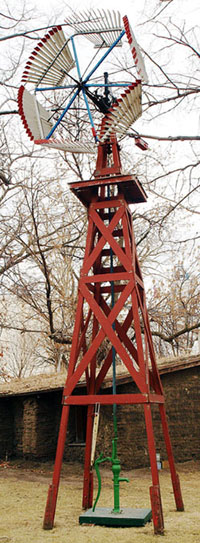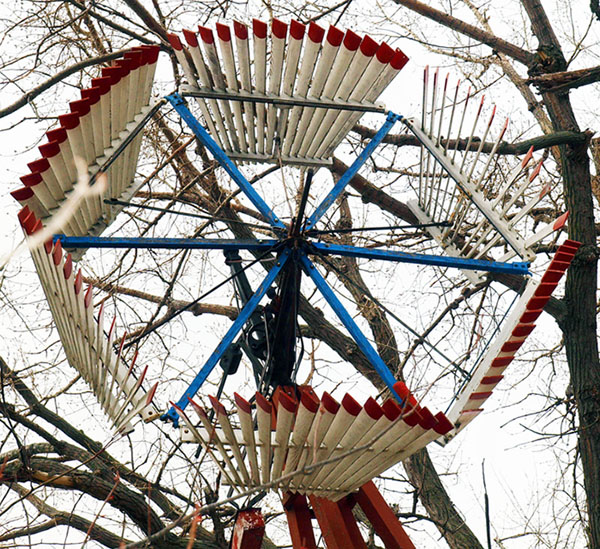The Sectional Windmill
Today, sectional windmills. The University of Houston's College of Engineering presents this series about the machines that make our civilization run, and the people whose ingenuity created them.
The problem of pointing windmills into the wind is a century old. Medieval mills had a long strut that let millers turn the whole fan structure on a central post as the wind shifted. Mid-18th-century British engineers invented a secondary fan blade, rather like the control propeller on a helicopter tail. It was set perpendicular to the main fan. When it turned it drove a mechanism that turned the mill until it faced straight into the wind.
But new windmill uses arose in 19th-century America as we settled the Great Plains. There, we didn't need to power large grain and textile mills. We needed small reliable windmills to pump water for cattle troughs and steam locomotive boilers -- windmills to function with minimal maintenance and management. They had to stay pointed into light winds, and had to shut down in strong winds.
A vast array of reliable windmill designs competed to solve that problem. They offered a dizzying array of means for controlling the pitch of blades, fan orientation, and rotational speed.
 It all began when a businessman, John Burnham, recognized the unique windmill needs in our American West. He turned to a brilliant mechanic, Daniel Halladay, and there begins an odd story of technological evolution: In 1854, Halladay patented something similar to the metal windmill we all know. A rear vane steered a wheel with large steel blades to face the wind. He also saw where his market was, and moved his new factory from Connecticut to Chicago.
It all began when a businessman, John Burnham, recognized the unique windmill needs in our American West. He turned to a brilliant mechanic, Daniel Halladay, and there begins an odd story of technological evolution: In 1854, Halladay patented something similar to the metal windmill we all know. A rear vane steered a wheel with large steel blades to face the wind. He also saw where his market was, and moved his new factory from Connecticut to Chicago.
Then, after the Civil War, he offered a better design. He arranged 84 thin wooden blades in six wedge-shaped sections. They were made of durable, weather-resistant cedar. As the wind picked up, a centrifugal controller tilted the sections forward like flower petals, or a pioneer woman's bonnet, to catch less wind. The collapsed sections of this strange machine looked just like an umbrella, blown inside out.
These windmills were widely used until the 1920s and were still for sale in 1940. Countless companies made versions of them while metal windmills lay fallow. Yet today, when we hear "farm windmill", we immediately imagine that familiar metal one, pumping water in our prairies. Some of us even notice how its wind vane folds parallel with the blades to slow it in a high wind.
Metal windmills were around since the latter 19th century, but farmers found the wooden ones easier to repair with a hammer and nails. It took a long time, but the reliability of metal windmills won out. And today, few of us have ever seen an old sectioned wooden windmill. Or, if we have, we probably took that collapsed umbrella shape to be no more than broken wreckage.
I find this strange indeed. We celebrate vintage cars and air-planes. We delight in Victorian houses and steam locomotives. But this strange gadget -- the once ubiquitous wooden farm windmill -- well you'll probably have to check out the Engines website to see what one of them actually looked like.
I'm John Lienhard at the University of Houston, where we're interested in the way inventive minds work.
T. L. Baker, A Field Guide to American Windmills. (Norman, OK: University of Oklahoma Press, 1973).
R. L. Hills, Power from Wind: A History fo Windmill Technology. (Cambridge: Cambridge University Press, 1994): Chapt. 9.

Above: a fortuitous photo taken on the fly from Interstate 5 in Oregon revealed this sectional wooden windmill still in use. It is probably a Monitor Vaneless windmill, which was still being made in 1940.
Below and in the text above: A Dempster sectional wooden windmill from the Pioneer Village Museum in Minden Nebraska. (All photos by J. Lienhard)
These windmills are both shown partially closed. The actually open up wide.
